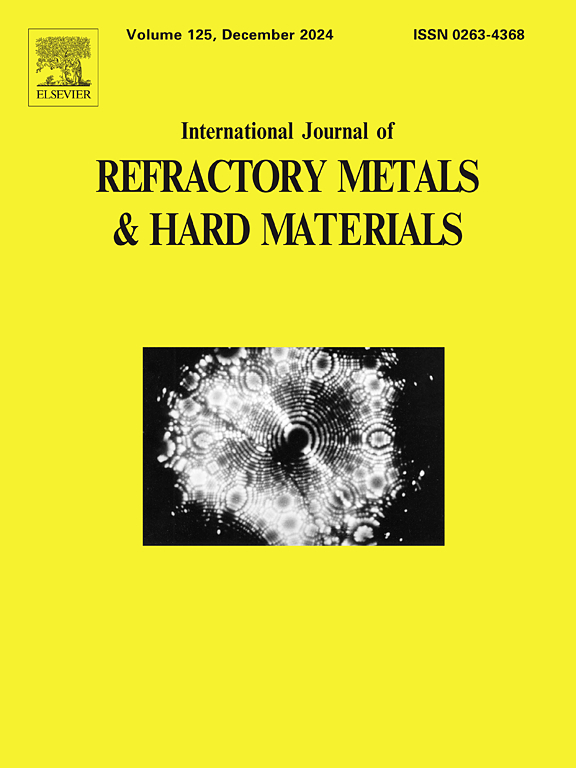The wear behavior of (Ti, W, Mo, Cr) (C, N)-based cermet under a wide load range
IF 4.2
2区 材料科学
Q2 MATERIALS SCIENCE, MULTIDISCIPLINARY
International Journal of Refractory Metals & Hard Materials
Pub Date : 2025-02-25
DOI:10.1016/j.ijrmhm.2025.107122
引用次数: 0
Abstract
The solid solution carbonitride -based cermet such as (Ti, M)(C, N)-based cermet (M represents transition metals) with low mismatch interfaces, hold significant potential to application in molds, cutting tools, and other wear-resistant parts. However, their wear behavior and mechanisms under reciprocating sliding contact and wide load range remain unclear. Herein, we investigate the unlubricated tribological behavior and wear mechanisms of (Ti, W, Mo, Cr)(C, N)-based cermet at a wide load range from 5 N to 100 N. Under low load, (Ti, M)(C, N)-based cermet exhibits excellent wear resistance compared to traditional Ti(C, N)-based cermet. The low friction coefficient and wear rate are attributed to the synergistic effects of transition metal oxides, particularly the self-lubricating properties of molybdenum trioxide (MoO3). Under high loads, the wear mechanism changes from the formation and failure of oxide layers, to accelerated abrasive wear and subsequently to an extremely slow wear caused by the Al-rich adhesive layer generated from elemental transformation between the tribo-couples. Furthermore, the strong interfacial bonding helps prevent crack growth between the core and rim phases. This study provides a theoretical basis and guidance for further improving the wear resistance of (Ti, M)(C, N)-based cermets and expending their potential application domains.
研究了(Ti, W, Mo, Cr) (C, N)基金属陶瓷在大载荷范围内的磨损性能
固溶体碳氮基金属陶瓷,如(Ti, M)(C, N)基金属陶瓷(M代表过渡金属),具有低错配界面,在模具,切削工具和其他耐磨部件中具有巨大的应用潜力。然而,在往复滑动接触和大载荷范围下,其磨损行为和机理尚不清楚。在此,我们研究了(Ti, W, Mo, Cr)(C, N)基陶瓷在5 N ~ 100 N宽载荷范围内的无润滑摩擦学行为和磨损机理,在低载荷下,(Ti, M)(C, N)基陶瓷与传统的Ti(C, N)基陶瓷相比,表现出优异的耐磨性。较低的摩擦系数和磨损率归因于过渡金属氧化物的协同作用,特别是三氧化钼(MoO3)的自润滑性能。在高载荷作用下,磨损机制由氧化层的形成和破坏,到加速磨粒磨损,再到摩擦偶之间元素转化产生富al粘接层导致的极慢磨损。此外,强界面结合有助于防止核心和边缘相之间的裂纹扩展。本研究为进一步提高(Ti, M)(C, N)基陶瓷的耐磨性,拓展其潜在的应用领域提供了理论基础和指导。
本文章由计算机程序翻译,如有差异,请以英文原文为准。
求助全文
约1分钟内获得全文
求助全文
来源期刊
CiteScore
7.00
自引率
13.90%
发文量
236
审稿时长
35 days
期刊介绍:
The International Journal of Refractory Metals and Hard Materials (IJRMHM) publishes original research articles concerned with all aspects of refractory metals and hard materials. Refractory metals are defined as metals with melting points higher than 1800 °C. These are tungsten, molybdenum, chromium, tantalum, niobium, hafnium, and rhenium, as well as many compounds and alloys based thereupon. Hard materials that are included in the scope of this journal are defined as materials with hardness values higher than 1000 kg/mm2, primarily intended for applications as manufacturing tools or wear resistant components in mechanical systems. Thus they encompass carbides, nitrides and borides of metals, and related compounds. A special focus of this journal is put on the family of hardmetals, which is also known as cemented tungsten carbide, and cermets which are based on titanium carbide and carbonitrides with or without a metal binder. Ceramics and superhard materials including diamond and cubic boron nitride may also be accepted provided the subject material is presented as hard materials as defined above.

 求助内容:
求助内容: 应助结果提醒方式:
应助结果提醒方式:


